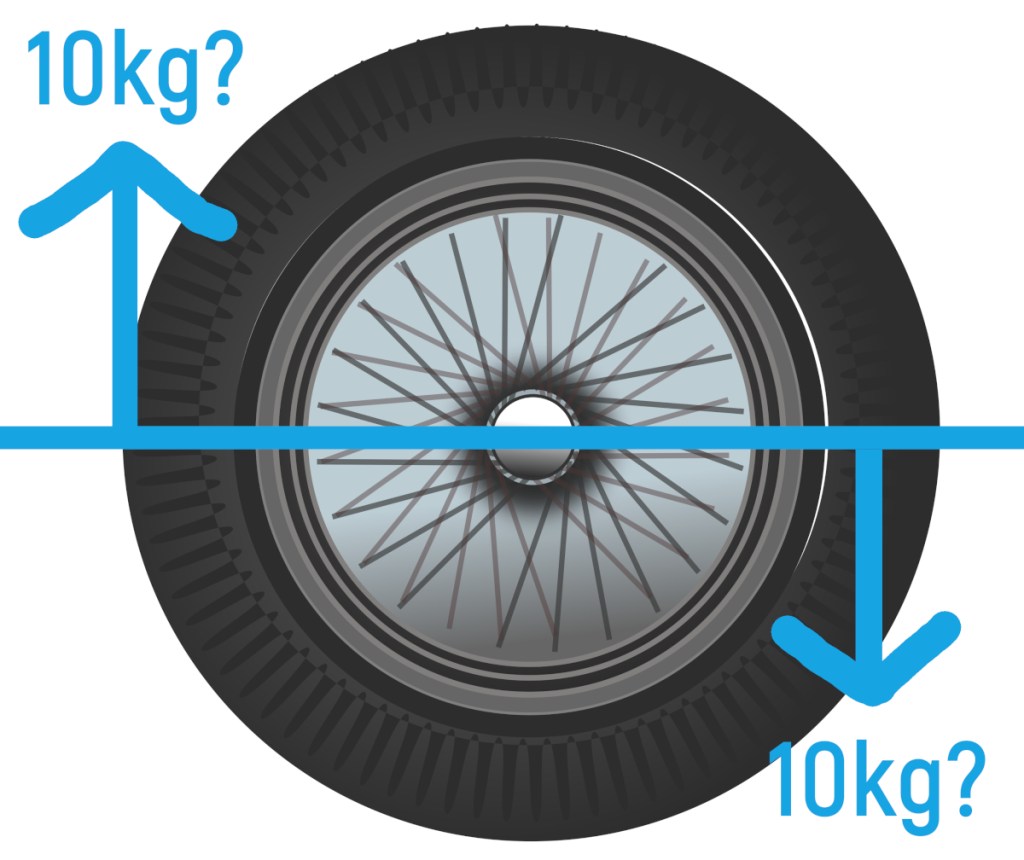As with all things in life, balance is key… Even the weight of your car wheels too! If you feel that your car is shaking when driving above 120 km/h, or maybe you feel vibration through the steering wheel,...
 Looks familiar, doesn’t it? This is the most common wheel balancing technique that you will find in Malaysia aftermarket workshop!
Looks familiar, doesn’t it? This is the most common wheel balancing technique that you will find in Malaysia aftermarket workshop!Source
As with all things in life, balance is key… Even the weight of your car wheels too!
If you feel that your car is shaking when driving above 120 km/h, or maybe you feel vibration through the steering wheel, you might want to consider getting your wheels balanced.
If you’re unfamiliar with wheel balancing, fret not. This topic will tell you everything from A to Z about wheel balancing.
What is wheel balancing?How are wheel balancing done?Static BalancingDynamic BalancingRoad Force BalancingThe Bottom LineWhat is Wheel Balancing?
Wheels are never exactly the same weight all around. Wheel balancing is the act of balancing the weight distribution of the tyre and wheel assembly so that it rolls evenly and smoothly. This is not to be confused with wheel alignment, which is an adjustment on the vehicle’s suspension so that you can position your wheel differently, but it doesn’t adjust the weight distribution of the wheel itself.
 Wheel balance is about the weight balance. Is the top and bottom half of the wheel the same weight? What about the left and right?
Wheel balance is about the weight balance. Is the top and bottom half of the wheel the same weight? What about the left and right?
Why does this matter? Let’s explore that with something that we can all relate to. Imagine that you are carrying a 10kg of groceries with your left hand. Because it’s so heavy on one side, you will start to notice that your body tilts towards the heavier side to compensate for the weight distribution. If it changes the way you walk, it can definitely affect the way tyres roll.
Now how did this happen? Wheels don’t have to carry groceries bag but plenty of things can go wrong. Just to name a few…
All rims only have one valve stem hole (the hole we use to fill our tyres with air) and that takes away a tiny amount of weight from that side of the rim.Tyres can’t be manufactured to perfectly round shape, and that causes the weight distribution to be uneven.Depending on various factors (how we drive, road condition, wheel alignment etc etc), tyres will wear out unevenly, causing one part of the wheel to lose more weight then the other.These are minor differences and are mostly invisible to the naked eye, but it will cause the tyre to roll unevenly. With just 50g of difference and enough speed, it can start to show up as vibrations in the car, causing irregular and damaging wear to your tyres.
How are Wheel Balancing done?
The core essence of all wheel balancing is to find out if your tyre is imbalance, where is the imbalances, and how much counterweights we need to put to make it balanced.
That’s the whole idea. But the million dollar question is how?
There are three ways you can get your tyres balanced, namely (i) Static Balancing, (ii) Dynamic Balancing, and (iii) Road Force Balancing. Don’t worry, it’s not as complicated as it sounds. We promise.
Static Balancing
Static balancing is the act of balancing the center of gravity of your wheel around its axis of rotation. It is a single-plane balancing where you are only concerned about the vertical imbalances. When out of balance, it has the capacity to make your tyre vibrate up and down.
Okay, we’re not trying to score an engineering degree here.
Let’s just say that static balance means that you only care whether the top half of your tyre is equally heavy as the bottom half of the tyre. If the top half is heavier, then it will rotate downwards until the heavier side is at the bottom. Now, all you need to do is add counterweight at the lighter part of your wheels until the tyre learns how to remain stationary regardless of its position.
DriveMag Riders showing how it’s done, even with only a vice!As you can see, it’s a technique that’s pretty straight forward, cheap and easy to execute . However, this method of balancing is almost obsolete and you should not rely on this kind of balancing for your car. It was helpful for older, narrower tyres but modern tyres that are wider than 10cm needs… *drum rolls* dynamic balancing.
Dynamic Balancing
Dynamic balancing is a dual-plane balancing, where you are concerned with the vertical AND horizontal imbalances. It’s the culprit that makes your tyre shimmy from side to side.
In layman’s term, dynamic balance means that you now care not only whether the top half of your tyre is equally heavy as the bottom half, you also care whether the left half is equally heavy as the right half.
Modern day tyres are becoming wider and this is the reason why static balancing is becoming obsolete. If you think about it… The wider your tyre, the more “meat” it has on the left and right and the more opportunity for it to become imbalance. Therefore, the more important dynamic balancing becomes.
To fix dynamic imbalances, you can consider getting an off-car dynamic spin balancing. This is the most common form of wheel balancing technique you will find in Malaysia’s aftermarket workshop (as of year 2019). All you need to do is remove the tyre, secure it safely onto the balancing machine, key in the dimensions of your wheel, and let the machine work it’s magic.
Conrad’s Tire Express & Total Car Care keeping it transparent and real. Beginning from 2:04, they’ve demonstrated exactly how a dynamic wheel balancing would have been done in a Malaysian workshop.The machine will spin your tyre up to 140km/h to test the dynamic balance of your tyre. As a rule of thumb, the imbalances are not to exceed 0.5% of the weight of your tyre. Then, the machine will to tell you exactly where you need to put the weights on the tyre and how much weight you need to correct the imbalances. It’s quite magical really.
Once the weights have been applied, the mechanic will usually test it one more time to make sure that everything is in perfect working condition.
Road Force Balancing
Road force balancing is like the premium fine-dining option in the world of wheel balancing. It’s mainly used in original equipment factory. But not so much in the aftermarket. In addition to just spinning the tyres, it also presses a large roller at 500kg ~ 600kg of pressure against the tyre. This helps to simulate the weight of the vehicle on the tyres in a real driving situation. Take a look!
Very informative video that brilliantly condensed everything you need to know about road force variation into a short 2 minute video.Now just why do we need that?
All tyres have some sort of variation in the sidewall stiffness because of the way they are manufactured. You can imagine having multiple springs that extends from the centre of your tyre rim to the tyre treads in a circle. When the stiffer spring is in contact with the road, the tyre deforms lesser because the stiffer spring is able to withstand more force. Needless to say that the weaker spring will deform more.
The end result?
Your car wheel is no longer round when you are driving, even though the car wheel is physically and perfectly round when you remove it from your car. I like to think of it like an egg. No matter how well you can balance the weight of the egg, it’s still an egg. It’s oval in shape and will roll like an oval egg. That’s not how we want our car wheel to roll.
That being said, road force balancing is the cream of the crop. Most of us won’t need this unless you are sporting a low profile, thinner tyres. This is because the distance from the rim to the tyre is smaller and stiffer, which will amplify the imperfections within the tyres. But if you want the absolute best, definitely consider road force balancing.
The Bottom Line
And, that’s it! You are now an expert in wheel balancing. We’ve discussed what is wheel balancing, why do you need it and some of the common wheel balancing techniques out there that you can get.
We hope that you find these materials helpful and if there is anything you’d like to add, feel free to contribute to the article by sharing your personal experiences on wheel balancing. You know we always love to hear a good wheel balancing story, so why not share it with the world!
Anyway, thank you for checking out D S Auto’s blog. Next time if your car is shaking, consider getting yourself some wheel balancing action.
Until then, drive safe and drive smart!
The post A gentle introduction to Wheel Balancing appeared first on D S Auto.















